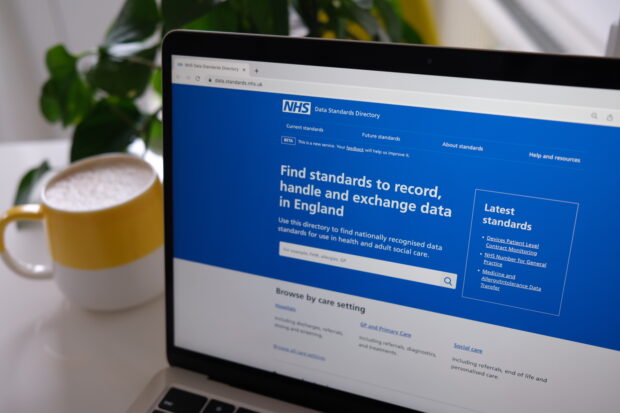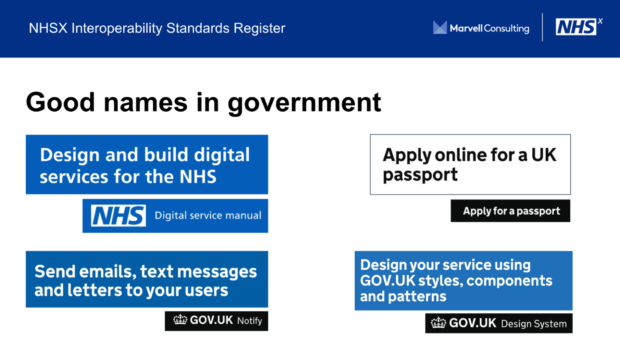
In 2021 I joined a discovery led by data expert Irina Bolychevsky of NHS England. The focus was how we could help information professionals, developers and others find the standards needed to support interoperability in the NHS.
Interoperability allows IT systems to communicate. An example is nurses being able to update GP records directly using their own systems instead of sending emails.
To achieve this, everyone needs to use standards to collect and format information in the same way and have the confidence to share it across organisational boundaries. The term ‘interoperability standards’ refers to the standards needed to achieve this.
Interoperability is an important part of the government’s goal to reshape health and social care using data. The pandemic showed how important it is that systems can communicate quickly and reliably with one another. In a modern healthcare system staff should be able to access information straight away, no matter its source.
One barrier in the health and social care sector however, is that interoperability standards are published by multiple organisations, making them hard to find. Our ambition was to solve that.
The confusion around language
Starting this work, the first problem we found was there didn’t appear to be widely used language conventions for talking about interoperability and standards.
Stakeholders had different understandings of what ‘interoperability standards’ were or what the terms ‘interoperability’ or ‘standards’ meant, with the term ‘standard’ used to describe lots of different things. Much of the information that existed was academic, confusing and sometimes inconsistent.
This meant that people were talking to - but not always understanding or agreeing with - one another, an issue confirmed in user research:
“The thing is…there are different definitions of interoperability. That [contract that has interoperability as a requirement] is going to fail, because the people who issued it don’t really understand what interoperability means” Chair, interoperability discussion forum
“Different people mean different things by ‘standard’” Data Architect, NHS Digital
“A key question at the moment is whether we have the technical knowledge to be able to assess against interoperability standards” Head of Technology Standards and Assurance, NHSX
There was also the problem that the word ‘interoperability’ is not well understood by non-experts. What did all this mean for people on the frontline? As one user put it:
“You do have to get used to the language...there is quite a steep learning curve!” IT supplier
This was an important finding. Research by the Behavioural Insights Team suggests that if people don’t understand something, or if terms mean different things to different people, this could be a major barrier to communication and ultimately achieving change.
If we wanted people to adopt standards, and central staff to hold them to account for using them, we had to start by helping everyone speak the same language.
Rethinking interoperability as our focus
A related question was whether framing this service around the standards needed for interoperability was the right approach.
Yes, standards are essential for joining up care but there are other benefits, such as it’s cheaper to use the same technical specifications than build bespoke integrations between different solutions. Arguably, those benefits might be equally important to healthcare leaders.
We also heard that not all care settings have the resources to do all the work needed to join up their IT systems right now, but there’s still value in standardising how data is structured so they can share it later.
The more we learnt, the more it felt like framing the service around interoperability risked turning people away, either because they didn’t understand the language, weren’t aware of all the benefits realised by adopting standards or they didn’t feel in a position to achieve interoperability right now.
Our hope was that reframing the service away from the policy goal (interoperability) and towards the action users could take (using standards) would increase standards usage, helping get everyone closer to interoperability in the long run.
Exploring a new name for the service
With the problem identified, the team set about finding a way to reframe the service in a way that would help all our users find, understand and use these standards.
Our user researcher explored the search terms people were using to find these standards. I researched language used by similar services in the UK and internationally to see where we could align and help tap into any existing mental models users might have.
We also held a naming workshop with stakeholders to get their views and understand any sensitivities around specific terms.
As a result, over several iterations and following extensive user testing, we changed the short and long service names from:
NHS Interoperability Standards Register
Find standards for data and interoperability in health and adult social care
To:
NHS Data Standards Directory
Find standards to record, handle and exchange data in England
The new name is still being tested but so far the changes seem to be helping users better understand the scope of the service. As one person remarked, “it does what it says on the tin”.
It’s also had an unexpected benefit of helping us avoid scope creep, which has been a real challenge in a space with so many unmet user needs. By giving the service a clear name, it’s become harder to see how it could be changed to encompass a lot of other content or features and still be clear enough for users.

What’s next
The NHS Data Standards Directory is now live and we welcome feedback. We know we have a long way to go to make it as valuable as users need it to be.
However, this service is only one small part of a bigger ambition. During the original discovery 9 barriers to interoperability were identified (links to supplier website), 7 of which extend beyond the remit of this service.
Now, new teams are exploring problems such as how you speed up the standards development cycle or improve the quality of data standards - all through that vital user-centred, agile, lens.
It will take many more years to achieve interoperability but by continuing to listen to people on the frontline and designing services around them, we have a much better chance of getting there.
Thanks to editors
It takes a village to raise a child… and to create a clear user-centred blog post. With thanks to: Kuba Bartwicki, Emma Harvey, Lisa Jeffery, Amy McNichol, Gemma Richardson and Sara Wilcox.
Key takeaways
- It can take time to identify the right service to build and how to frame it
- Content designers can help by exploring solutions not just through the lens of what users need, but also what makes sense
- Sometimes to achieve a policy goal you need to first help everyone understand the subject matter
1 comment
Comment by Kerry Lyons posted on
Fantastic blog Nadia, tackling a complex area and written in a really clear way. Interesting to hear that ‘standards’ means different things to different people. Something we’ve also seen in DfE. Good luck with it all!